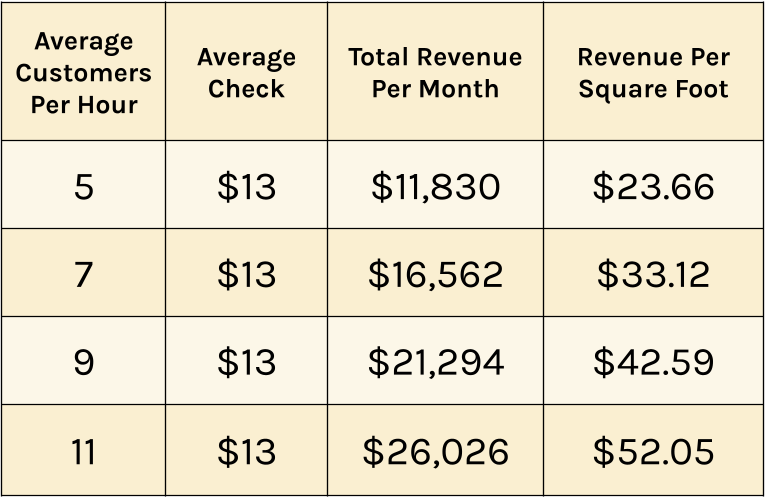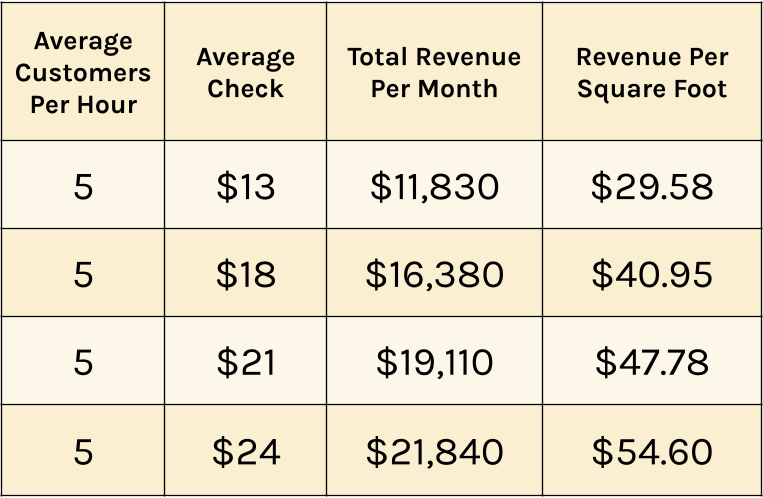I want to talk about taproom revenue per square foot.
I’ve been at Small Batch Standard for a little over a year, and on multiple occasions I have heard the metric of taproom revenue per square foot brought up.
We consider your taproom square footage to be the space usable by your customers.
We do not include behind the bar, kitchen, or brewery space, but only that which can be used for customer seating.
Your square footage drives the number of customers allowed in the taproom at one time.
Taproom revenue per square foot is a metric that isn’t thought much about, and when it is, the questions are usually around why it matters and not how to actually increase it.
With that being said, why does it matter what your revenue per square foot is?
Let’s take a look at an example.
Downtown Expansion
We worked with a client recently who has a taproom on the outskirts of town.
They wanted to build a downtown facility to increase visibility with tourists visiting the area.
Rent, of course, is higher in the downtown area, so they needed help figuring out if it would work.
The usable space in the taproom was 400 square feet. This allows for 40 people in the taproom at one time. Rent was $15,000 per month. They plan to be open 1-8PM Tuesday to Sunday (182 Hours Per Month).
We analyzed the numbers with them to see what it would take to make this work. (Hours Per Month x Average Customers Per Hour x Average Check Amount divided by Square Footage = Revenue Per Square Foot)
Their current results:

While these numbers supported the outskirt location, downtown would require more revenue.
Where do they go from here?
Using these numbers, they’ll be able to calculate how many average customers they need to support their costs.
You have to think about what your square footage can support.
So, here’s some thoughts on how you can increase taproom revenue per square foot.
First Steps
As it so often does, part of the solution comes down to having a great product. The beer HAS to be good, or the rest of your work won’t pay off.
So, get that right first. Have a product that people want and you will fill up your taproom. Easy fix, right??
Just kidding. We know this is tough, but it’s where it all starts.
Effective branding and appearance of your taproom is also a crucial step in attracting customers.
Again, we know this is difficult, but important.
Focus on interesting, consistent branding that your target customer can relate to. This might not be your strong suit, and outside help may be required, but it’s very important in bringing customers to your taproom instead of the next one over.
Once you’ve nailed these, there are a couple more things you can do to maximize taproom revenue per square foot.
Taproom Layout
First, make sure your taproom is laid out in a way that the space is maximized.
Think about table size and shape and how they can be moved around if needed to accommodate different sized parties.
Think about the shape of your room and how to fill small, weird spaces, maybe with 2 seaters in mind.
Or, can you cycle customers out more quickly to increase the number of customers per hour?
These practices will increase your customers per hour, driving up your revenue per square foot and total monthly revenue.

Great, more seats. Now what?
Filling the Space
Think about how you can bring in more people during slow times.
Taproom only beers are huge for this.
Start with a monthly can release but limit the number to-go, with the rest available for taproom consumption only.
Of course, cooking up some great food can help, but bringing in a food truck, or snacks such as pretzels, charcuterie boards, etc, can drive up revenue if a kitchen isn’t possible.
Do you have TVs for sports (if that’s your taproom vibe) or games that would bring people in on the random Tuesday evening?
Can you host a weekly trivia, karaoke, or bingo night?
When you put these into place, you’ll hopefully increase your customers per hour, but your customers will hopefully be spending more per check as well.
Look at what happens to Revenue Per Square Foot as your Average Check goes up:

More tips can be found here and here.
COVID
The third and final consideration, that may hit much closer to home given the events of the last year, is:
What happens when the number of customers allowed in your space is reduced by the government?
How do you make up the shortfall and produce enough income to cover your expenses?
When COVID hit, capacity for most taprooms was cut drastically. While this didn’t change your square footage, it did reduce the allowable number of customers in your space, which affects the revenue that is being earned.
If you need space to facilitate 75 customers in order to generate enough revenue to support your taproom, and you’re only allowed 30, how do you make up this gap?
Promoting cans to-go and price increases come to mind.
And, while this doesn’t increase revenue per square foot, can you open up a patio or sidewalk for additional seating?
How about a barrel-aging room?
The point is to maximize your space, and squeeze as much revenue as you can out of what you have.
So, get creative!
Keep asking these questions, keep brainstorming, and keep considering these factors as you plan ahead.
Taproom revenue per square foot may not be at the top of your mind, but it’s something you need to think about, especially given the events of the last year.
Maximizing this will set you up for future growth and success.
-Derek